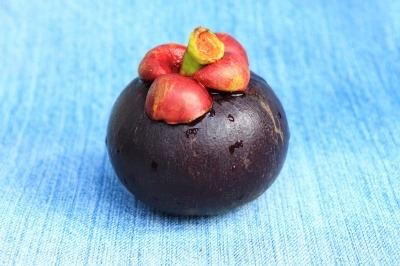
Mangosteen (Garcinia mangostana L. (GM)) is a popular East Indian fruit from the tropics. The fruit is globular in shape with a purple-brown rind (pericarp) and is similar in size to a small apple. The rind encloses delicate white flesh or locules similar to a tangerine or orange. These are are the edible parts and is often called the Queen of tropical fruits in South-East Asia. It also resembles a lychee when peeled with a semi-translucent appearance.
It is cultivated like lychee in mainly the tropical rainforest – Indonesia, Sri Lanka, Malaysia, Philippines and Thailand rather than China.
The flavour is described as peach, pineapple, strawberry and grape in no particular order or combination.
The rind is relatively thick and used as an astringent (MacMillan, 1943) and contains large amounts of tannic acid and stable purple anthocyanins which could be used as natural food colour.
There has been a lot interest expressed in this fruit for its nutritional health benefits and indeed there are some corporations devoted to maximising the potential of this fruit. Many of its properties come from the high level of xanthones present.
The peel and not the fruit (aril portion) has been used in traditional medicines for the treatment of a range of conditions such as abdominal pain, diarrhoea, astringent, dysentery, infected wound, suppuration, chronic ulcer, leucorrhoea and gonorrhoea (Pedraza-Chaverri et al., 2008).
Mangosteen Anthocyanins
The main anthocyanin producing the purple-brown colour is cyanidin-3-sophoroside. A smaller, almost insignificant amount of the other pigment is cyanidin-3-glucoside (Du & Francis, 1977).
Zarena and Sankar (2012) then isolated pelargonidin 3-glucoside. The current content is Cyanidin 3-sophoroside (76.1%), followed by cyanidin 3-glucoside (13.4%) and pelargonidin 3-glucoside (6.2%) Zarena & Sankar, 2021).
The presence of a highly stable polyphenol oxidase in the rind makes extraction of mangosteen anthocyanins for food use difficult and uneconomic. The kinetics of this enzyme has been examined. Blanching improves colour extraction because heat degrades enzyme activity (Deylami et al., 2016).
Mangosteen Nutraceuticals
The peel is the source of a range of nutraceuticals mainly xanthones such as mangostin, tannin, xanthone, chrysanthemin, garcinone, gartanin, Vitamin B1, B2, C and other bioactive substances but these are rarely incorporated into the pulps (Jung et al., 2006). The volatile flavour componentry has been identified (MacLeod and Pieris, 1982). The total volatile content is claimed to be low, less than 3 g/kg, which contributes to their delicate aroma (Pino, 1998).
A related species in the genus is the Malabar Mangosteen (Garcinia cambogia) which contains hydroxycitric acid, an important agent used in weight management products.
References
Deylami, M. Z., Rahman, R. A., Tan, C. P., Bakar, J., & Olusegun, L. (2016). Effect of blanching on enzyme activity, color changes, anthocyanin stability and extractability of mangosteen pericarp: A kinetic study. Journal of Food Engineering, 178, pp. 12-19 (Article).
Du, C.T., Francis, F.J. (1977) Anthocyanins of mangosteen, Garcinia mangostana. J. Food Sci., 42(6) pp. 1667-8 (Article)
Jung, H.A., Su, B.N., Keller, W.J., Mehta, R.G., Kinghorn, D., (2006). Antioxidant Xanthones from pericarp of Garcinia mangostana (Mangosteen). J. Agric. Food. Chem. 54, pp. 2077–2082.
MacLeod, A.J. and Pieris, N.M. (1982) Volatile Flavour Components Of Mangosteen, Garcinia mangostana. Phytochemistry 21 (1) pp. 117-119
MacMillan, .H.F. (1943). “The Tropical Planting and Gardening, With Special Reference to Ceylon,” 5th ed. MacMillan & Co., London. Pedraza-Chaverri, J., Cárdenas- Rodríguez, N., Orozco-Ibarra, M. and Pérez-Rojas, J.M. (2008). Medicinal properties of mangosteen (Garcinia mangostana). Food Chem. Toxicol. 46, pp. 3227-3239.
Pino, J.A. (1998) Volatile Constituents Of Tropical Fruits. IV. Kiwifruit, Star Fruit And Mangosteen. Alimentaria 286 pp. 47-50
Zarena, A. S., & Sankar, K. U. (2012). Isolation and identification of pelargonidin 3-glucoside in mangosteen pericarp. Food Chemistry, 130(3), pp. 665-670.
Hi, Just read your article. Can you expand on the health benefits a bit. I’ve read some really disappointing posts on the 7 or 20 benefits and they never state the references. I see you do from the other articles I’ve read but I’m interested in this fruit. I gather the antioxidant properties are perhaps the most important features. Tam my B.